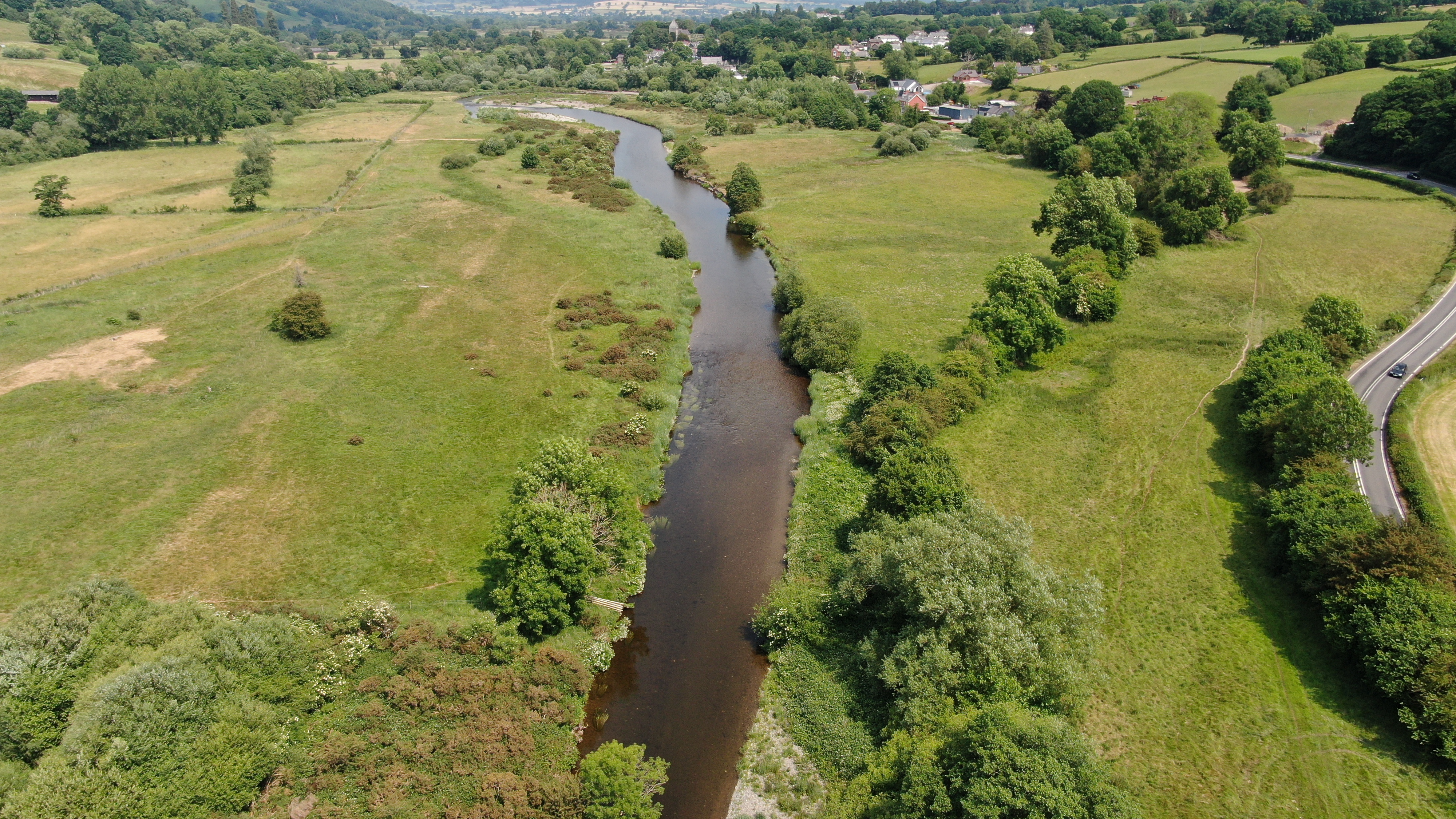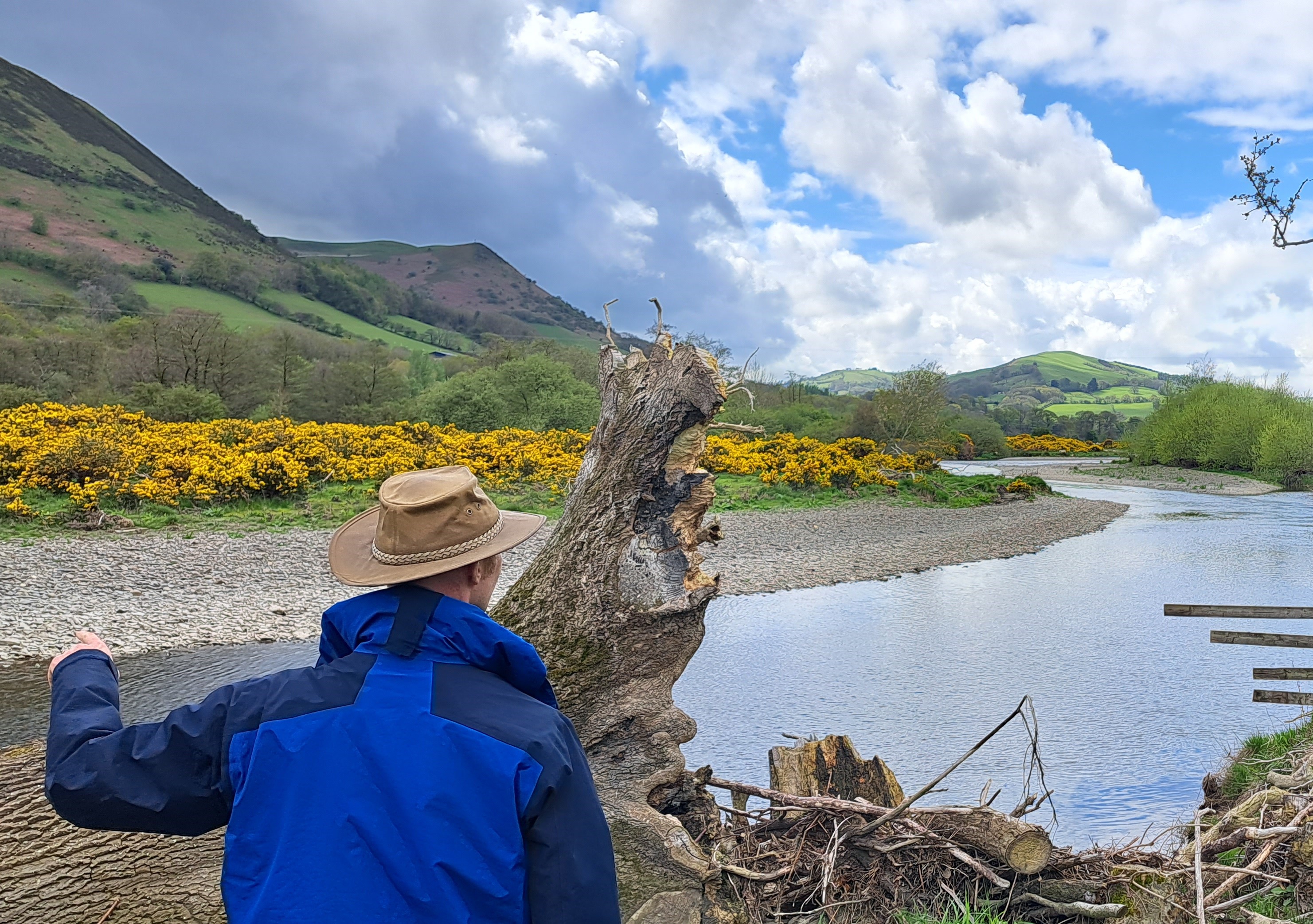Llandinam Gravels River Restoration Project
Overview
Natural Resources Wales (NRW) is working on a project to restore important habitat along a stretch of the River Severn in the village of Llandinam.
The area, known as Llandinam Gravels, is a nature reserve. The shallow gravels provide great habitat for invertebrates to thrive, for wading birds to feed and for migratory fish such as salmon to spawn.
But historic human intervention, such as straightening the river channel and gravel removal, has altered the river’s natural processes and incised the channel. As a result, the channel is no longer dynamic. This is deteriorating the habitat present through the nature reserve and increasing erosion nearer the village.
Our project to restore natural river processes and increase these habitats will be one of the largest lowland river restoration projects in Wales, with the potential to become a notable case study on process led restoration.

Please use the drop-down menus below to find out more.
The importance of the River Severn
The River Severn is the longest river in the UK at approximately 220 miles long. It rises in the Cambrian Mountains and flows through Powys before crossing the border into Shropshire and travelling down to form the Severn Estuary.
The river gravels provide places for invertebrates to thrive and for wading birds to feed and breed. Over 500 species of invertebrates live in exposed river gravels and form the basis of our food chain.
The river is designated for migratory fish species such as Atlantic salmon, sea lamprey and twaite shad whose populations are increasingly threatened.
________________________________________________________________
What we plan to do
The project is part of our ambitious river restoration programme in Wales, which aims to restore natural river processes and reintroduce habitat which has been lost due to historic human activity.
We aim to restore a section of the River Severn, approximately 900m long, back to a more natural state.
The project team is made up of multiple disciplines and after reviewing many design options with partners and specialists the preferred option is designed to enable the river to undertake its own natural recovery to a wider multiple channel form. This method encourages the river to use its own natural processes, requiring less engineering.
The scheme will be located to the south of Llandinam village and covers an area of approximately 25 hectares. The northernmost boundary of the site extends to Llandinam car park, the A470 forms the eastern boundary and the southern and western boundaries are within the Llandinam Gravels Nature Reserve.
Our plans include:
-
Restoring the historic river channels and gently grading them into the floodplain. This will kick start natural processes that the river wants to take but is currently unable to due to human interventions over time.
- Installing large wood objects in the new and existing channels and the floodplain to encourage more natural, slower movement of sediment across the whole site. At present, sediment movement is exacerbated, increasing erosion as well as sediment deposition, particularly near the village.
As well as providing a host of benefits for nature, the scheme is expected to provide an overall reduction in the speed and erosive power of the river during high flows.
View the display boards presented to the community at our drop in event on 9th September.
________________________________________________________________
Latest updates
September 2024
On the 9th September we held a public drop in event to provide an opportunity for local people to learn more about the proposals and to ask questions.
The project team are currently reflecting on the queries we received and will be able to share formal responses in the coming weeks.
View the display boards presented to the community at our event.
May 2024
During 2023, working with our consultants Binnies and CBEC (restoration specialists for the water environment) we have undertaken a number of surveys and investigations to inform the design of the scheme. Some of these include:
- Hydraulic modelling to estimate flow, water level and velocity in river channels.
- Geotechnical desk study to review relevant information regarding the historical, geological and environmental data of a site
- Topographic survey (also referred to as a land or terrain survey), a type of survey that maps the levels, boundaries and features of a site.
- Ecological surveys to assess the presence of invasive or protected species.
- Archaeology report to locate, identify, and record the distribution, structure, and form of archaeological sites in relation to the project area.

An initial concept design for the scheme has been developed, and we are now working to finalise our proposals into a detailed design.
We aim to present our plans to the community and receive feedback in the coming months. We will obtain relevant consents and permissions in order to start construction of the scheme during summer 2025, subject to funding.
_________________________________________________________________
Frequently Asked Questions
Will you be consulting on plans for the scheme?
We will be holding drop-in sessions in the community to keep you informed and providing a newsletter to keep people updated. We will also be working closely with Montgomeryshire Wildlife Trust who owns and manages the Llandinam Gravels Reserve.
Do you have funding to construct the scheme in 2025?
We are applying for funding through the Welsh Government's Nature and Climate Emergency (NaCE) Capital Programme to deliver the Llandinam Gravels project next year. Funding may not be available due to wider NaCE programme pressures.
The programme supports a number of environmental priorities including peatland restoration, metal mine remediation, fisheries, water quality and national forests.
Will the project reduce flood risk to people living in Llandinam?
The scheme has not been specifically designed to reduce flood risk, however, restoring natural river processes, reconnecting floodplains and slowing and spreading flood flows over a greater area upstream may have associated benefits by managing water levels downstream.
A different NRW project carried out a preliminary assessment which unfortunately found that flood risk management funding could not be justified for Llandinam at that stage, predominantly on the grounds of value for money.
In a separate scheme, Powys County Council has installed a small earth bund to reduce flood risk to properties in Llandinam.
Will you be dredging the river as part of the project?
Dredging of natural rivers is generally very damaging to the habitats and species present, but also to the neighbouring land and properties up and downstream.
No dredging will be undertaken as part of these works, instead we will be reconnecting the river to the flood plain and restoring natural processes.
Natural Resources Wales reminds landowners not to remove gravel from streams and rivers. In-river works, such as gravel removal, dredging or alteration of a channel, is an offence unless the work is carried out under an appropriate permit or consent.
Gravel removal operations cause damage to wildlife, including aquatic invertebrates, fish spawning grounds and nesting birds. It also spreads invasive non-native species such as Japanese Knotweed to other locations resulting in infestation and damage to neighbouring property. Such operations de-stabilise the river and can rapidly and massively change the course of the channel. It can take decades to centuries for a river to recover from inappropriate works.
Removing gravel from rivers is only permitted under certain circumstances and where it is clearly evidenced to be absolutely necessary to do so.
How will Invasive Non-native Species be managed?
We have identified a number of different types of invasive non-native species (INNS) present within the works area. These INNS are present across the catchment, and eradication is not within the remit of this local project - the Llandinam Gravel River Restoration aims to restore freshwater habitats through restoring natural processes.
Note that landowners have a responsibility to ensure that INNS do not spread from their site, but there is no legal requirement to manage INNS on their land. Managing INNS is best done in a coordinated way, involving the community, and we are aware of Montgomeryshire Wildlife Trust INNS management activities at Llandinam Gravels.
If construction of the Llandinam Gravels River Restoration Scheme were to obtain funding, NRW would be responsible for ensuring that the construction work does not spread INNS off site. INNS have been considered in the design of the work and appropriate biosecurity will be implemented to manage the risk of spreading INNS. The project is also liaising with the landowner in relation to local INNS management.
If you are seeking advice on INNS, please see this website. As a local community you can help by reporting species through this website or you can get involved in the Wildlife Trust's volunteering activity.
_________________________________________________________________
Get in touch
To get in touch with the team, please email: Llandinamgravels@naturalresources.wales
www.naturalresources.wales
Llandinamgravels@naturalresourceswales.gov.uk
03000 65 3000
Areas
- Llandinam
Audiences
- Rivers
- citizens
- Anglers
- Wales Biodiversity Partnership
Interests
- WFD
- water framework directive
- water planning
- river basin planning

Share
Share on Twitter Share on Facebook